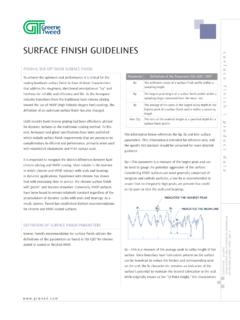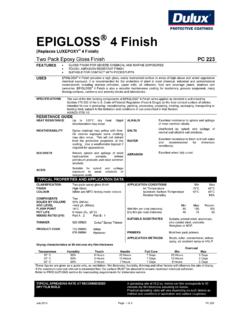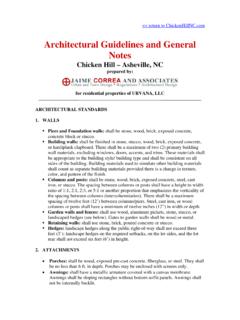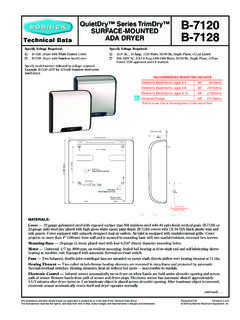Transcription of ALUMINIUM SURFACE FINISHING USER’S GUIDE
1 " SURFACE FINISHING - anodising, powder coating or wetcoating - is a process enhancing the properties ofaluminium in all its forms to give it a decorative visualappearance, to improve the metal's excellent corrosionresistance and to improve its wear resistance." ALUMINIUM Federation ofSouthern AfricaLight, Strong & BeautifulALUMINIUMAALLUUMMIINNIIUUMMSSUU RRFFAACCEE FFIINNIISSHHIINNGGUUSSEERR SS GGUUIIDDEEINDEXI ntroduction3 ASFA3 SURFACE FINISHING defined3 Types of SURFACE Finishing4 FINISHING Processes5 Atmospheric Corrosion6 SURFACE Finishes Comparison 8 Anodising11 Powder Coating15 Wet Coating18 Care and Maintenance19 Contact Details20 References20 ALUMINIUM the MaterialAluminium is a remarkable material. It has a uniquecombination of properties that make it suitable for manydifferent applications in various alloy is a light metal whose strength, corrosive anddecorating properties can be improved by alloying with variousother metals.
2 It has good tensile strength over a wide range oftemperatures and has excellent corrosion resistance. Whenaluminium is exposed to air, a thin, glass-hard oxidised filmforms on the SURFACE . This oxide film clings tenaciously to themetal's SURFACE , presenting an effective barrier to the coating can make corrosion resistance even is an excellent conductor of heat and electricity. It ishighly reflective of light, heat, radiant energy and electric wavesand is non-magnetic. It is non-sparking, does not ignite or burnand is non-toxic. It can be formed by all known metal workingprocesses, is simple to fabricate and is suitable for joining,bonding and welding. It can be melted, cast, extruded, rolled,formed and machined. It is infinitely recyclable, an importantfeature in this age of energy and resource ALUMINIUM SubstrateFor a wide range of applications ALUMINIUM and its alloyshave the advantage that they are protected by the material snatural hard and inert SURFACE oxide layer that is formed inair and aerated water and that reforms instantly wheneverthe metal is cut or abraded.
3 This oxide film inhibitscorrosion and consequently, in some uses such as industrialand agricultural roofing and cladding, ALUMINIUM is routinelysupplied in mill finish. Even windows have been suppliedin mill finish - the doors and casements in theJohannesburg Jeppe Street Post Office being a 70 yearold example, as is the Durban harbour Bayhead demands of corrosion resistance, SURFACE protectionand aesthetics have however relegated mill finish tothose situations where corrosion is slow and theproduct does not need to have a particularly attractivesurface finish. The SURFACE finishes for ALUMINIUM that arecovered in this GUIDE fall into three main groups beinganodising, powder coating and wet is an Association operatingunder the aegis of the AluminiumFederation of Southern is an AFSA publication and allcontents are copyright to : (011) 453 3339 Fax: (011) 453 3403E-mail.
4 ALUMINIUM SURFACE Finishers Association (ASFA) replacedthe original Anoda that was formed in 1992 as an Associationunder the aegis of the ALUMINIUM Federation of Southern Africa(AFSA) - to address the needs of companies involved in thesurface FINISHING of Purpose of the Associationis to represent its membersin matters of common interest or concern in the fields ofaluminium SURFACE FINISHING , relevant quality and environmentalmanagement and related research, technical advice andtechnology achieving its purpose, ASFA will, amongst other things:zProvide a forum where members can discuss technicalmatters of common quality ALUMINIUM SURFACE FINISHING that ASFA smembers offer their customers, adhering to relevantSANS and other International Quality the awareness of ALUMINIUM FINISHING and itsapplications through technical interchange and the mutual benefit of membership to the surfacefinishing industry, including use of the ASFA hallmark / a customer focussed education / advice /information service including maintenance of relevanttechnical training support and education for members andaluminium Stockists' mandated representations on behalf of membersand the Industry on relevant matters opposite thrives on the participation of its members.
5 TheAssociation, through its members and the Federation,incorporates the best knowledge pool in ALUMINIUM surfacefinishing in Southern Africa. Over the years, this knowledge hasbeen accessed to produce a definitive GUIDE on aluminiumsurface FINISHING in South Africa, namely the " ALUMINIUM SurfaceFinishing User s GUIDE ". This publication contains technical andpractical guidelines and has proven successful with architects,specifiers and other users of SURFACE finished stakeholders include companies engaged in aluminiumfinishing, suppliers of products and services to the finishingcompanies, purchasers of coated products and specifiers ofsurface is SURFACE FINISHING ?With the wide selection of goods available to consumers, firstimpressions are extremely important. Often, the value andsuccess of the product is based on immediate judgements - anda critical factor in this regard is the article's appearance provides an ideal base for further FINISHING of goodsin the form of a decorative coating.
6 The size and range ofsurface finished products is vast - including goods in thepackaging, mechanical engineering, transport, automotive,electrical, pharmaceutical, architectural, building, domestic and'white' goods markets. Colour addition is used for decorative,instructive and protective coatings may look similar at first glance, but there are manyfactors that will influence the lifespan of a good or bad surfacefinish over time. SURFACE quality is directly dependent onsurface treatment, film thickness, process control and provedspecified for too long simply as a means of corrosion protection, SURFACE treatments in fact modify the condition or properties ofthe SURFACE of the metal in a variety of ways:zThey modify certain properties of the metal SURFACE suchas SURFACE hardness and abrasion alter its contribute to the decoration of the assist the adhesion of coatings such as paint, varnishand bonding provide further protection from corrosion whileimparting a durable appearance to the is only a single aspect of FINISHING as the total cost must betaken into account.
7 Developers, contractors, specifiers andother users of coated ALUMINIUM products are well-advised totake all the necessary measures to ensure that proven qualityassurance practices are maintained, thus ensuring that anygiven project will have the best ALUMINIUM finish most common types of SURFACE treatment for aluminiumalloys are:zDegreasingzMechanical SURFACE treatmentzChemical SURFACE treatmentzChemical conversionzChemical brighteningzAnodising (anodic oxide)zPowder coatingzWet coating3 TABLE 1: Types of SURFACE TreatmentTypeTechniqueCharacteristicsExt rudedFine lines on extruded surfaceDecoration, Guidelines to future positioning, Fine lines cover small / brushingPolish and buffingVibration polishingHigh finish polishingShot / grit blastingFine lines in the direction of grinding. Gives a silk or matt a flat even grinding lines partly disappear with polishing.
8 Reduces stress risers .Removes die lines and tool marks and SURFACE a matt to shiny SURFACE suited to small batches and mass produced finish, usually followed by bright cast ALUMINIUM components to remove cast skin and improve (prior to anodising)Chromating / phosphatingElectrochemically plating withcopper, tin, nickel or silverRemoves SURFACE to desired depth. Can be used for to various FINISHING processes. Leaves a matt or silky appearance. Different etchants leave slightly different textures that may show up inanodising SURFACE texture and gives a mirror finish. Film usually < 15 micronsPretreatment prior to powder or other coating corrosion resistance / gives good soldering SURFACE /conductivity and anodisingHard anodisingElectrolytic polishingGives a hard, natural or coloured oxide layer up to 25 for decoration - resists pitting corrosion but also adds wear resistanceand electrical a grey to brown coloured hard oxide layer of 75 - 125 used for engineering purposes to resist abrasion / a smooth SURFACE with high surfacecoatingPowder coatingScreen printingCoating with protective foilsWet coatingGives various degrees of protective and decorative finishes that can withstandheavy chemical attack (provided SURFACE coating is unbroken).
9 Printing of text, d cor patterns, decoration, protection or other used in capital intensive operations for coil coating, effective andefficient. Mainly for building of SURFACE Finishing4 Type of Finish to be SpecifiedThere are a number of factors to consider when specifyingsurface finishes. Different FINISHING processes may be specifieddepending on the use or application of the final product. Someof the factors to be considered are:zAppearance: bright, matt, coloured, brushed, otherzEnvironment of use:zInterior (architectural, commercial, decorative, other)zExterior (architectural, marine)zIndustrial / Automotive (corrosive or non-corrosiveapplication, resistance to wear or abrasion, other)zUnderground (mining, cabling, piping)zAerospace (corrosive resistance, dielectric, emissivity,fatigue strength, other)Criteria for Specifying FinishThe performance of SURFACE treatments depends directly on thequality of the SURFACE preparation.
10 Anodising and powdercoating are complex processes that are constantly beingimproved. Specifiers should insist on adherence to SANS orInternational Standards to ensure that the SURFACE finishperforms in the expected specifying SURFACE finishes for ALUMINIUM products, thefollowing specific criteria should be addressed:zAlloy and temper of ALUMINIUM to be usedThe alloy and temper of the product to be anodised will affectboth the strength and appearance of the part after it is combinations of constituent elements cause eachaluminium alloy to react differently in the coating process; thisis particularly evident between alloy series. As a result, eachalloy or alloy series yields a different appearance, even iftreated to identical coating processes. zMechanical finish, if any is requiredIf specified, mechanical FINISHING is done before chemicalfinishing or andodising.









